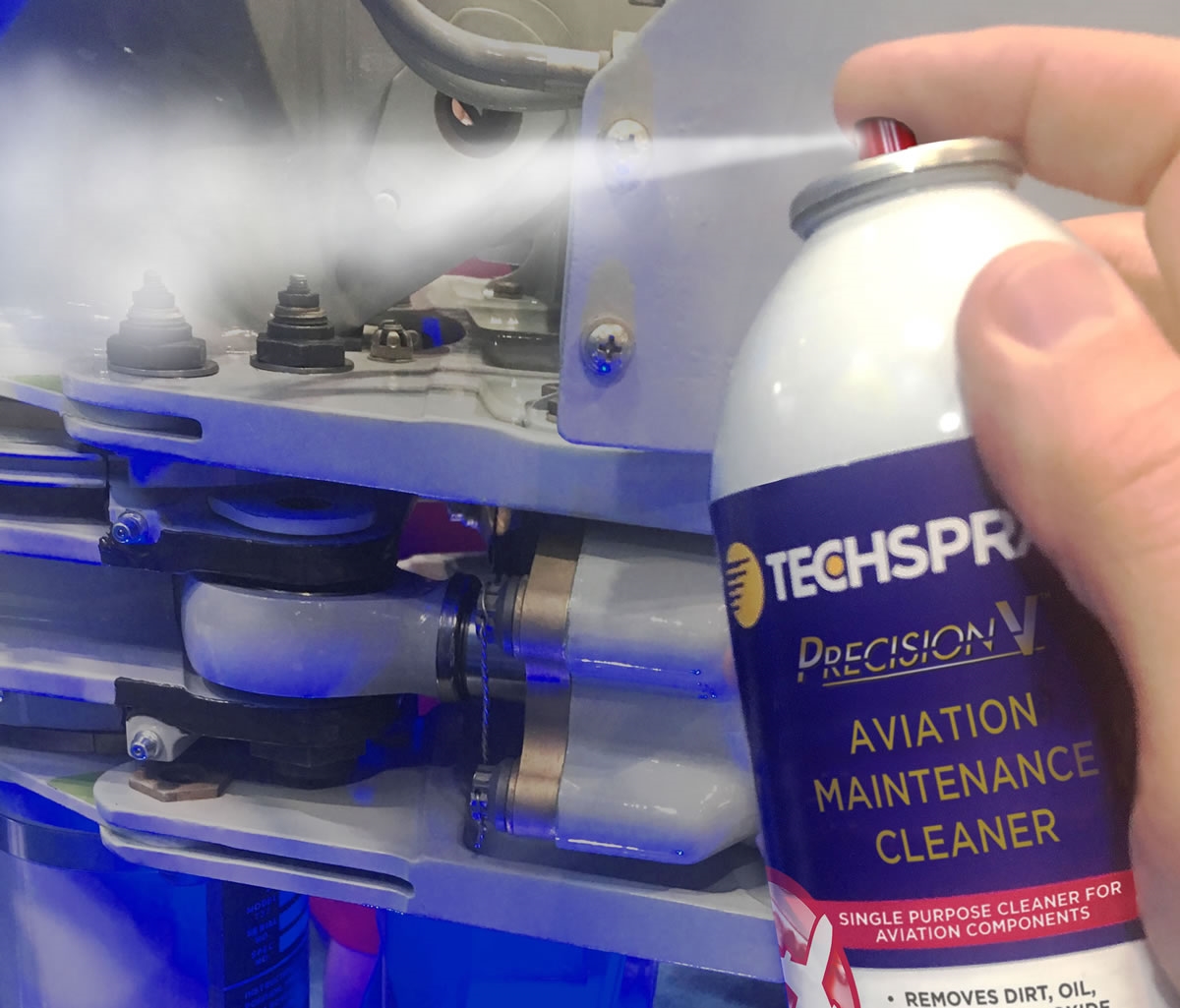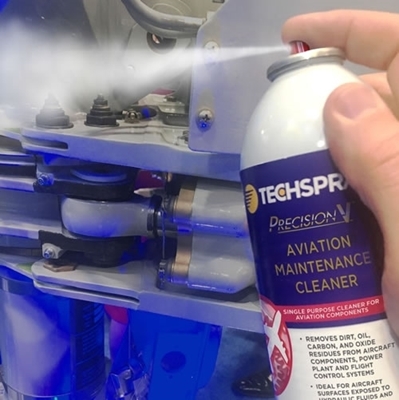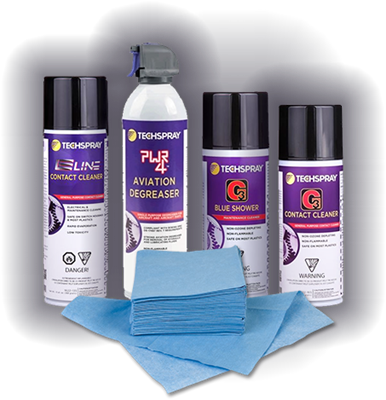A major US-based airline MRO facility was struggling to replace AK225, a class of chemical that was pulled from the market in 2015 due to restrictions on ozone-depleting products. It was particularly challenging as AK225 was VOC-exempt, so it allowed cleaners to be NESHAP-compliant. Luckily Techspray was able to offer an option that was NESHAP-compliant, frost-free, and with good cleaning performance.
What is AK225?
Beginning January 1, 2015, HCFC-225 (also called “AK225”), a common precision solvent for high-end cleaning, was banned for usage per the Clean Air Act under the Montreal Protocol.
AK225 is a mixture of two isomers, HCFC-225ca and HCFC-225cb. A common product for HCFC-225 is from Asahi Glass Company marketed as Asahiklin AK-225, a precision cleaning solvent. AK225 has many unique properties, including good solvency, nonflammability, and thermal stability.
AK225 is VOC-exempt per the EPA. VOCs (volatile organic compounds) are smog-producing compounds that are highly regulated. AK-225 also has a low acute toxicity (the exposure level of AK-225 is 100 ppm 8h TWA compared to 200 ppm for Trans), low viscosity (meaning that it flows well), high density (which will displace water), and low surface tension (allowing it to flow well into tight crevices). Unfortunately, due to the ozone-depleting potentials of HCFC-225ca and HCFC-225cb, 0.02 and 0.03, respectively, it was phased out.
What Is the NESHAP Requirement & Why Is It So Challenging?
The National Emission Standards for Hazardous Air Pollutants Aerospace Manufacturing and Rework Facilities (NESHAP, 63.741-753) is an EPA (US Environmental Protection Agency) rule, which was finalized in 1995, that restricts emissions for aviation rework facilities.
While the regulation was initially intended to reduce hazardous air pollutants (HAP) used in aerospace / aviation MRO facilities, it was expanded to include restrictions on VOCs. For example, “hand-wipe and flush cleaning operations” are required to use cleaning solvents with a vapor pressure of less than 45mm Hg. The unintended consequence of the ban on ozone-depleting solvents was a forced shift towards higher VOC solvents.
For aviation MRO cleaning, the goal is to minimize the trade-offs between price and performance. The regulated move from ozone-depleting compounds alongside the NESHAP requirement to reduce VOCs left maintenance operations with few options. Most compliant options are much more expensive and with lower cleaning performance.
The Search for NESHAP Compliant AK-225 Alternatives
The major US-based airline MRO facility in our case study was using neat (100%) AK225 solvent in aerosol packaging for degreasing and contact cleaning around the maintenance shop. When the 2015 deadline finally approached, a decision had to be made. Because the qualification process of aviation cleaners commonly takes months, and sometimes years, because of the inherent risks involved in aviation safety, the initial solution was to stockpile the current AK225-based product. This was allowed by the Clean Air Act, but of course was only a stopgap measure.
Fast forward four years, and they shifted to a cleaner manufactured under a common aviation brand. While the cleaner was non-ozone depleting and NESHAP compliant, it was extremely expensive, did not clean adequately, and tended to frost the surface. Frost not only adds the potential for thermal stress, but it freezes the soil making it even more difficult to remove.
Operators were not happy with the move from a tried-and-true cleaner to the alternative, and made their feelings known loud-and-clear. That was when Techspray was called in to offer an alternative.
After extensive in-house testing at the Techspray lab, cleaning many of the most common aviation oils and greases, Precision-V Aviation Maintenance Cleaner (part #2870-19S) was recommended. Once the SDS was approved by the health & safety department, two cases of samples were brought in and distributed to operators on the shop floor. The reaction was extremely positive, so a change to Precision-V Aviation Maintenance Cleaner was authorized within two months.
Precision-V Aviation Maintenance Cleaner
Techspray's aviation MRO line breaks new ground in safety and performance for precision solvent cleaning, aircraft component degreasing, contact cleaning, and avionics repair.
Our R&D team works one-on-one with aircraft manufacturers and major aviation maintenance, repair and overhaul facilities (MRO) to identify the root cause of their challenges and develop safer products that meet performance and compliance requirements.
Precision-V Aviation Maintenance Cleaner is a nonflammable, frost-free, and fast-drying solvent for removing dirt, oil, carbon, and oxide residues from airframe, power plant and flight control systems. It is formulated for cleaning painted aviation components and assemblies, and minimizing repair downtime.
For added safety when cleaning energized contacts, Precision-V has a dielectric withstand voltage of 41K.
Precision-V Aviation Maintenance Cleaners has environmental advantages, with zero VOC (per EPA) and low global warming potential (GWP). It is compliant with NESHAP VOC requirements 63.741-753. It is also compliant with European F-gas restrictions, so the same product can be used in aviation MRO facilities around the world.
It has been tested to be safe on aircraft surfaces per NASA/TP-2015-218207 and SAE ARP1176.
For more information, contact your Techspray application specialist at 678-819-1408 or info@itwcce.com.
References
Daniel, J., Velders, G., Douglass, A., Forster, P., Hauglustaine, D., Isaken, I., et al. (2007). Scientific Assessment of Ozone Depletion: 2006, Global Ozone Research and Monitoring Project -- Report No. 50. Geneva: World Meteorological Organization.
EPA (1998). “National Emission Standards for Hazardous Air Pollutants Aerospace Manufacturing and Rework Facilities.” Federal Register. Vol. 62, No. 169. https://www.govinfo.gov/content/pkg/FR-1998-09-01/pdf/98-23322.pdf
EPA (1995). “Fact Sheet; Final Air Toxics Rule for the Aerospace Manufacturing and Rework Industry.” https://www.epa.gov/sites/default/files/2015-11/documents/1995_final_factsheet.pdf






